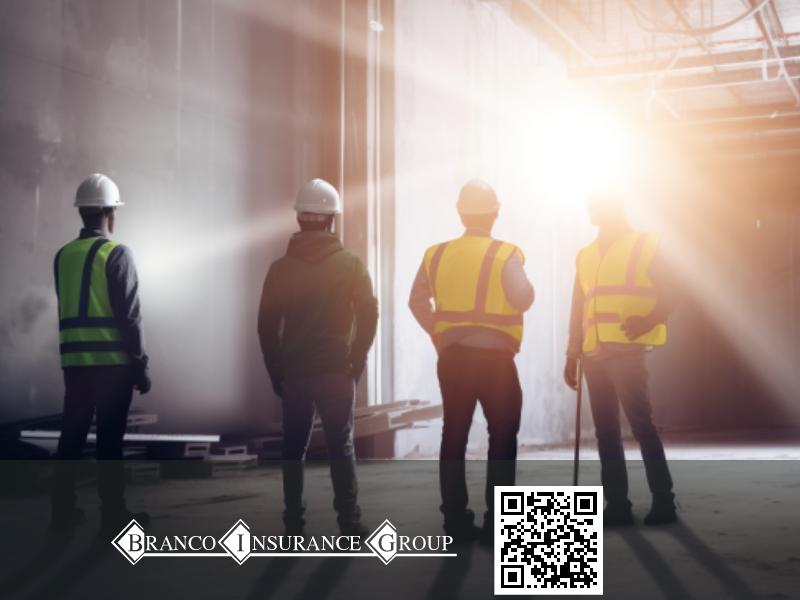
Mental Health Awareness Month: Prioritize the Mind, Support the Heart
May is Mental Health Awareness Month, a time to reflect on the importance of emotional well-being and the invisible battles many face daily. At Branco

Embarking on a construction project, whether it’s a new build or renovation, can be both exciting and daunting. With many moving parts and potential risks, ensuring the safety of your investment should be a top priority.
Enter builders risk insurance – an essential safeguard protecting your property and materials during the course of construction. This specialized type of insurance not only provides peace of mind but also helps to mitigate financial loss due to unforeseen events such as fire, theft, or natural disasters.
Builder’s risk insurance is a specialized type of coverage that provides protection for buildings and structures during construction or renovations.
Builder’s risk insurance, sometimes referred to as “course of construction insurance,” is a specialized policy designed to safeguard construction projects from potential property damage and cover additional costs associated with unexpected incidents during the building process.
The primary purpose of builder’s risk insurance is to provide financial protection for property owners, contractors, and other stakeholders involved in a construction project.
For example, if severe weather damages a partially completed building or thieves steal valuable equipment from the job site, the builder’s risk coverage can step in to help offset these losses.
Builder’s risk insurance is essential for various parties involved in construction projects as it safeguards their financial interests and investments. For example, general contractors, property owners, architects, and developers should all consider obtaining this specialized coverage.
Subcontractors who perform work on a project may also require builder’s risk insurance based on the terms outlined in their contract with the primary contractor. Furthermore, if you’re a commercial property owner embarking on an extensive renovation or remodeling project, securing builder’s risk coverage can help protect your investment from unexpected damage or delays.
Builder’s risk insurance offers coverage for a wide range of construction projects, ensuring comprehensive protection for various residential and commercial endeavors. Below is a list of common types of projects that can benefit from builder’s risk insurance:
By identifying the type of project you’re undertaking, you can ensure that your builders’ risk insurance policy effectively covers your specific needs while mitigating potential risks throughout the construction process.
Builders Risk Insurance provides extensive coverage, including property damage caused by fire, theft, vandalism, or natural disasters; soft costs like rental expenses and profits lost due to construction delays; liability coverage; business interruption protection; as well as options for additional coverage such as debris removal and legal fees.
Builder’s risk insurance policies typically include property damage coverage, which protects the construction site and all materials on it from any physical damage. This can cover a range of incidents such as fire, floods, earthquakes, theft, or vandalism.
For example, if there is a fire at your construction site that destroys some of the building material before it’s installed, builder’s risk insurance could help you cover the cost of replacing that material.
Soft costs coverage is an important aspect of a builder’s risk insurance policy that covers expenses incurred by the contractor or owner if the construction project is delayed.
This can include additional interest payments, lost rental income, and similar extra expenses involved in completing the project on time. For example, if inclement weather or unexpected events impact construction schedules and cause delays, soft costs coverage can help cover these unanticipated expenditures caused by such disruptions to keep your business running.
Additionally, soft costs provisions in a policy offer protection for losses from the date of a covered loss until the normal operation has resumed or when repairs are completed.
Soft cost policies may differ depending on providers; some insurers offer comprehensive policies while others have more limited options.
In addition to property damage coverage, builder’s risk insurance may also include liability coverage. This type of coverage protects the policyholder from legal action and financial responsibility if someone is injured while on the construction site or if damage occurs to a neighboring property as a result of the construction project.
For example, if a worker falls and gets injured on your job site, your builder’s risk policy may cover their medical expenses and any legal fees associated with the claim.
Liability coverage is crucial for any builder or contractor who wants to protect their financial interests in case of an accident or incident during construction.
Builder’s risk insurance can come in handy when construction projects are delayed due to physical loss or damage. This is where business interruption coverage comes into play, as it can cover the loss of income or potential income during the period of delay.
For instance, if there is a fire outbreak on a construction site that causes significant damage to the project, this could result in the cessation of work for an extended period.
In turn, this will lead to possible income loss since no progress would have been made during that downtime.
Investing in builder’s risk insurance offers several benefits for those involved in residential or commercial construction projects.
Builder’s risk insurance is essential for protecting against theft and vandalism during construction projects. It provides coverage for damages caused by theft or vandalism of equipment, building supplies, and other materials on the job site.
For example, if a thief break-ins and steals expensive tools from the job site that are necessary to complete the project, the builder’s risk insurance policy can provide compensation for those losses.
Additionally, if vandals damage construction materials or destroy temporary structures on the property, builder’s risk insurance will provide coverage to repair or replace those items.
Natural disasters can cause significant damage to construction sites, which is why it’s essential to have adequate coverage through builder’s risk insurance. Standard policies typically cover natural disasters such as fire, lightning, and explosions that may occur during the construction process.
Builder’s risk insurance can help protect against financial losses due to property damage caused by these natural disasters. For instance, if a hurricane damages a building under construction or equipment on site was destroyed by an earthquake, your policy could cover the repair costs.
Keep in mind that specific terms and conditions of coverage will vary depending on the insurer you choose and the exact nature of your project.
Builder’s risk insurance offers additional coverage options beyond the standard policies. Consider these options to secure the right coverage for your construction project:
Builders’ risk insurance is not one-size-fits-all; work with your insurer to customize your policy’s coverage limits and endorsements based on your unique needs and budget constraints.
Builders risk insurance has key features such as coverage timeframe, limits and extensions that should be considered when selecting a policy to ensure the right level of protection for the construction project.
Builder’s risk insurance policies typically provide coverage for a period ranging from six months to one year. However, the policy term can be extended if the construction project is not completed on time.
It’s essential to note that there is no coverage under the policy if the building is occupied to any extent for over 60 days without written consent from the insurer. This means that it’s crucial to ensure that you have sufficient coverage for your project duration and factor in potential delays or extensions during construction planning.
When it comes to builder’s risk insurance policies, coverage limits are an important factor to consider. These limits refer to the maximum amount that an insurer will cover in the event of a loss or damage to the covered property during construction.
For example, if your project is valued at $500,000, you would want coverage up to at least that amount. Some policies also allow for the customization of coverage limits based on specific needs and risks associated with a particular project.
It’s important to work closely with your insurance provider or broker in order to make sure you have adequate coverage and understand any limitations or exclusions within the policy.
Builders Risk Insurance policies offer standard coverage for property damage, soft costs, liability, theft and vandalism, natural disasters, and business interruption. However, extensions can be added to the policy to provide broader protection tailored to the project’s specific needs. Here are some common coverage extensions that can be added:
By working with a broker to add these types of extensions to a Builders Risk Insurance policy, property owners can ensure they have adequate protection for their project’s specific risks and vulnerabilities.
To determine the cost of builder’s risk insurance, factors such as the construction project’s location, its duration, and overall value are considered by insurance providers.
The cost of builder’s risk insurance premiums depends on various factors, including:
Knowing these factors affecting premiums helps you make informed decisions when choosing builders’ risk insurance policies that meet your needs while staying within your budget.
To give you a better understanding of the potential costs associated with Builders Risk Insurance, we’ve compiled sample quotes for various construction projects. Keep in mind that these figures are for illustrative purposes only and may vary depending on factors such as location, type of project, and coverage needed.
Project Type | Construction Cost | Estimated Monthly Premium | Coverage Limit |
Residential Home | $250,000 | $200 | $250,000 |
Small Commercial Building | $500,000 | $400 | $500,000 |
Large Commercial Building | $1,000,000 | $800 | $1,000,000 |
Industrial Warehouse | $2,000,000 | $1,600 | $2,000,000 |
High-rise Condo Building | $5,000,000 | $4,000 | $5,000,000 |
Please note that these sample quotes are based on a standard Builders Risk Insurance policy, without any additional coverages or extensions. Actual costs may vary depending on the specific needs and requirements of each construction project. It’s essential to discuss your project details with a reputable insurer to ensure you get the appropriate coverage at the best possible price.
Looking for ways to save money on builders risk insurance? Here are some cost-saving measures to consider:
By following these cost-saving measures, you can obtain builder’s risk insurance without breaking the bank. Remember that pricing varies depending on several factors, such as the value of the property, type of construction, and duration of the project, so getting quotes from different insurers is essential.
To choose the right builder’s risk insurance, you should first identify your risks and coverage needs, research and compare policies from reputable insurers, and select a plan that offers the most comprehensive coverage options for your construction project.
Before purchasing builders’ risk insurance, it’s essential to identify the risks and coverage needs specific to your construction project. Start by assessing your project’s location, size, and scope to determine potential hazards such as natural disasters or theft.
Additionally, think about what types of materials and equipment are on-site that need protection. Identify any contractual requirements for insurance coverage that may exist between yourself and other parties involved in the project.
By taking these factors into consideration when choosing a policy, you can ensure you have adequate coverage for any unexpected events that may occur during construction.
Don’t forget to evaluate how much you’re willing to pay out-of-pocket in case of a loss event when selecting coverage limits.
To ensure that you choose the right builder’s risk insurance policy for your needs, it’s important to research and compare policies. Here are some steps you can take:
By taking these steps to research and compare policies from different insurance providers, you can choose a builder’s risk insurance policy that provides comprehensive coverage at a reasonable cost.
Choosing the right insurer for your builders’ risk insurance policy is essential to ensure financial stability and adequate coverage in case of any unforeseen events during construction.
It’s important to do some research and select a reputable insurer with experience in this specialized type of insurance.
Consider comparing different policies from these top companies to determine which one suits your needs best.
Keep in mind that brokers may charge fees for their services when selecting an insurer.
Builder’s risk insurance is a crucial investment for anyone involved in construction projects. It not only protects the property owner from financial loss but also gives peace of mind to contractors and builders.
Before selecting a policy, make sure to research and compare different options, identify coverage needs, and choose a reputable insurer. Keep in mind that factors like project size, materials used, and location can affect the cost of premiums.
Lastly, it’s essential to work with an experienced insurance broker or agent who can guide you through the process and answer any questions you may have.
Builder’s risk insurance is a vital protection for construction businesses and property owners. It covers unexpected events that can cause damage to structures during construction or renovations, including theft, vandalism, natural disasters, and more.
By understanding the various coverage options available and choosing the right insurance provider, property owners can ensure that their investments are protected against potential financial losses.
With builder’s risk insurance in place, builders and contractors can focus on completing projects without worrying about unforeseen circumstances causing a setback in time or money. If you are thinking about getting builder’s risk insurance coverage or if you still have questions about what this coverage can do for you, our experts at Branco Insurance Group are here to help. We will find the best policy and price for you so that you can have peace of mind when it comes to construction projects. Contact us today!
Builders Risk Insurance is a type of insurance policy designed to protect construction projects, including buildings or structures, during the period of construction. This insurance covers damages which can occur due to several factors such as fire, theft or natural disasters. It is important for builders and contractors to have Builders Risk Insurance because it protects their investment in the project from potential financial losses.
Builders Risk Insurance typically covers damages caused by risks like theft, vandalism, fire, lightning strikes or storms that result in property damage during the construction period. The coverage usually applies to materials on site (including tools), temporary structures like scaffolding; land excavation work; building foundations; and more.
It's recommended that you purchase Builders Risk Insurance at least two weeks before beginning your project. You want time enough between buying an insurance policy and starting work so any potential discrepancies are addressed - this includes possible changes in materials used on site or other updates that could alter the original planned structure of your construction project.
Typically contractors pay for Builder’s risk insurance since they're responsible for ensuring all aspects related to safety precautions and security measures while working on-site until completion of a given project However many agreements will offload these costs onto end clients who request specific policies be put into effect ahead of any work being completed similarly some general contractor arrangements might require subcontractors provide suitable proof-of-coverage before allowing them access onsite - either way make sure clarify with all parties involved what policies need arranging beforehand so there are no surprises down line

May is Mental Health Awareness Month, a time to reflect on the importance of emotional well-being and the invisible battles many face daily. At Branco

Two of Naugatuck’s long-standing insurance professionals have joined forces. Beginning on April 14th, the Healy-Lynn Insurance Agency has become a division of Branco Insurance Group.
